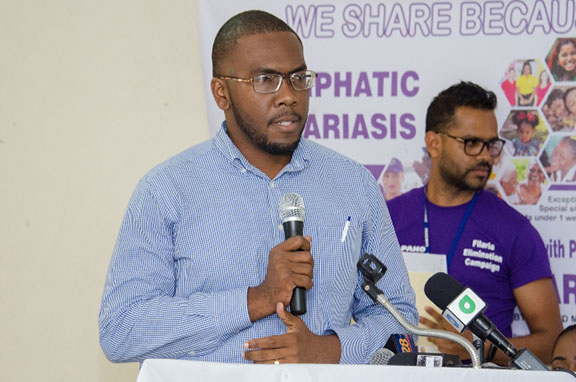The Ministry of Public Health’s Vector Control Services is collaborating with the Pan American Health Organisation/World Health Organisation (PAHO/WHO) office in Guyana to launch a revised Mass Drug Administration (MDA) campaign to eliminate filaria (lymphatic filariasis).
Lymphatic Filariasis, also known as Elephantiasis, is a parasitic infection caused by worms transmitted to humans through the bite of infected mosquitoes.
According to a statement from the Department of Public Information (DPI), this campaign is tentatively scheduled to commence in each of eight regions, during the last week of October and will run for 14 days and is part of a strategy to eliminate the disease from Guyana and by extension the Americas, for good.
The MDA campaign has been revised after PAHO/WHO statistics indicated Guyana is one of two countries in the Americas that are still to eliminate filaria (Haiti being the other country).
The exercise will focus on four additional endemic regions added to the campaign namely Moruca Sub-Region in Region One, New Amsterdam and surrounding areas in Region Six, Bartica and Lower Mazaruni Communities in Region Seven and Region Two respectively.
Critical to this revised campaign is the addition of a third drug, Ivermectin to the already administered Diethylcarbamazine (DEC) and Albendazole tablets, thus making the initial double-drug therapy now a three-fold.
Before the revision of the MDA campaign in Guyana, the exercise was rolled out in Regions 3, 4, 5, and 10. A recent remapping of all ten regions has shown that the coverage areas must be expanded for the rounds of IDA (Ivermectin, DEC and Albendazole) Mass Drug Administration to result in the successful elimination of filaria, hence the addition of the four additional regions.
Another significant part of this campaign is the fact that the dosage of this drug therapy will be based on a person’s height. Director of the Vector Control Services, Dr Horace Cox explains that the new strategy taken to prevent filaria is the most effective. “This year, we have determined, after assessing all perspectives, the best strategy is to measure the height of the persons that would be participating in the mass drug administration campaign… They will use a dose pole and on that dose pole, there are several demarcations…”
According to Dr Cox, the dose poll will outline the number of pills to be administered to the corresponding height measured and every pill distributor must utilise a dose pole before distributing pills in this revised campaign.
The collaborating agencies, Public Health Ministry and PAHO/WHO, have since engaged the media to spread the message that the Mass Drug Administration is the only effective and successful method of preventing Filaria in Guyana.
Focal Point for Neglected Infectious Diseases at Vector Control Services, Dr Reza Niles, disclosed that there is no cure for the chronic manifestation of filaria but there is prevention for the early stages of the infection. She added that the media plays a critical role in helping the public to understand. “A key component to any successful MDA is social mobilisation that is why we are engaging you the media to affect behaviour change. What is this behaviour change? For persons not just to take their pills but to acknowledge there is a problem, to defeat this problem,” Dr Niles was quoted as saying.
When the campaign is officially launched, pills distributors will visit homes and schools. They will also be established at fixed locations, such as offices, market places, places of worship, stellings and bus parks, thereby allowing everyone access to the pills, the release added.






